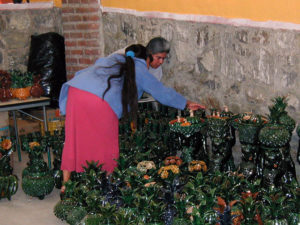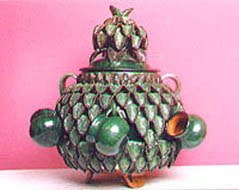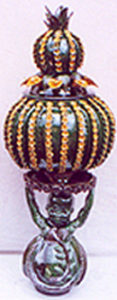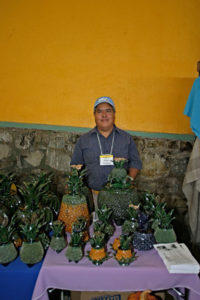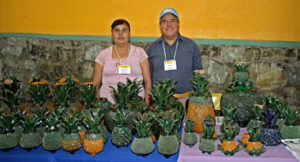Where others see a mass of shapeless clay, Hilario Alejos Madrigal envisions exquisite forms that are just waiting to be coaxed out. And it is this creativity that has played a key role in the success of this award-winning potter.
“It is necessary and very important to have an imagination,” Alejos explains. “A lot of imagination is needed in order to be able to produce a piece.”
This artistic vision is something that Alejos seems to have inherited from his mother, retired potter Elisa Madrigal. Born in Carapan, Michoacán, she eventually moved to San José de Gracia, Michoacán, where she still resides to this day, with her son and his family. It was here in San José de Gracia where Madrigal began crafting poncheras (punch bowls) in the shape of pineapples. As Alejos recounts, the artisans in San José de Gracia were mainly producing clay saucepans at that point in time, so his mother decided to create something different.
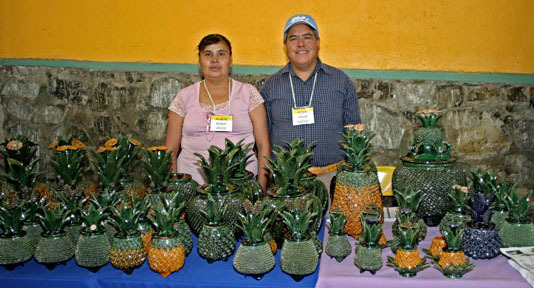
“She saw that there was a lot of competition and so it occurred to her to make a pineapple punch bowl,” Alejos says. “She had a lot of success with it. From there, it all started and she began to make a variety of pineapples.”
At a time when other boys were probably playing soccer or riding bikes with friends, a teenaged Alejos began sculpting pottery with his mother, who passed on to him the artistic tradition that would become his life’s work.
“I learned through her,” says Alejos, who is now 42 years old. “I learned how to work the clay and the whole process of a pineapple.”
Alejos’ three brothers, José María, Emilio and Bulmaro, also learned the craft of pottery from their mother. All four men have their own workshops in San José de Gracia, where they continue to carry on the family tradition started by the elder Madrigal, who is now in her eighties.
“In my mother’s era, the work was not the same as it is now,” Alejos notes. “Because year after year, one keeps improving, trying to make the work better, coming up with new ideas.”
Indeed, the artisan has diversified over the years, as his workshop now produces other pieces in addition to the famed pineapples. Here, lamps and candelabras are also created, as well as a new line of clay sculptures that are inspired by the indigenous women who live in Michoacán.
It is this drive to create new and different work that keeps Alejos’ imagination stoked. “First and foremost for the imagination, you have to have something in mind already about producing something new, something that has not come out before,” the potter explains.
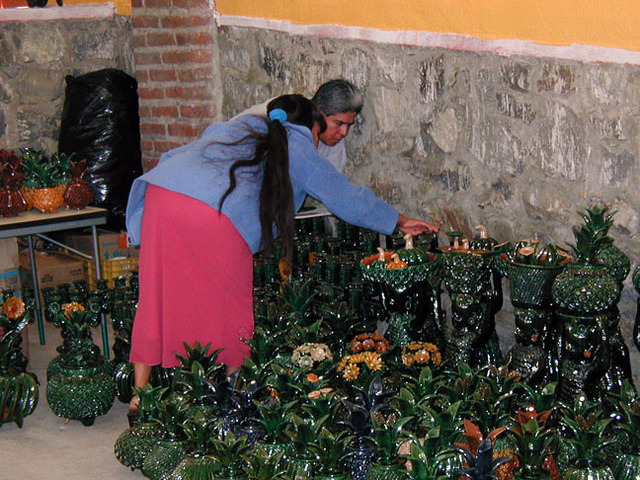
It is a collaborative process for Alejos, as his wife and several of his children currently work with him in the family-run studio that is attached to the house. Each pineapple sculpture takes about one week to complete, starting with the selection of the clay and ending with the piece’s final firing.
First, two types of clay are mixed together to form a material that will ensure a more durable piece. One of the clays used is tepetate, which has heat-resistant properties that keep the pineapple from cracking or exploding in the oven. The other is called barro fuerte (strong clay), according to Alejos, who says it keeps the pineapple from caving in on itself.
Once the clay is mixed, the body of the pineapple is formed through the use of a mold. The decorative elements, like the stem and skin, are then shaped and affixed by hand to the piece.
Next, a layer of claylike substance that Alejos refers to as tierra blanca (white earth) or pasta blanca (white paste) is applied. As the potter explains, this paste forms a base for the colored glazes that are applied later in the process.
After the paste is applied, the pineapple is fired in the kiln for a period of five hours. It is left to cool and then bathed in a glaze of lead oxide or copper oxide to give it a rich color. Silica is also applied, which results in the signature glassy shine. The pineapple is then placed back in the kiln for a second firing, which lasts five hours. The final result is an intricately detailed, smoothly glazed pineapple in tones of blue, green or yellow.
During the process, Alejos’ oldest daughters, 21-year-old Elizabeth and 20-year-old Gabriela, assist with applying the tierra blanca to the piece, while his 15-year-old son, Osbaldo, helps with the first firing. The artisan and his wife, Audelia Cerano – to whom Alejos refers as his “right arm” – take charge of the rest.
This family effort has produced some gorgeous specimens, including the biznaga and de conchita pineapples for which Alejos is most well known. The biznaga model is inspired by the cactus of the same name and as such, is decorated to look like a cross between a pineapple and this succulent plant. De conchita derives its name from the tiny shell-shaped pieces that comprise the skin of the pineapple in this model, since de conchita means “of little shells.”
Alejos’ signature pieces have garnered him various accolades in Mexico, including first and second prizes in the Noche de Muertos and Domingo de Ramos contests held in the cities of Pátzcuaro and Uruapan in Michoacán. He has also received fourth prize in the nationwide contest Gran Premio del Arte Popular that is held in Mexico City. Additionally, his work is highlighted in the cultural tomb entitled Grandes Maestros del Arte Popular Mexicano, which is published by the Fomento Cultural Banamex and features the potter’s biznaga pineapple on the cover.
“It motivates me a lot when I win a prize in a contest,” Alejos says. “It inspires me to keep moving forward and imagining new things so that I don’t get stuck. I like the work that I do a lot and of course, my family and I live off of it.”
However, aside from the prizes and the profit, Alejos’ work has a much deeper meaning for him. “All of my sentiments, all of my imagination are imprinted in a pineapple,” he says. “It is the way in which I share my imagination with people.”
Alejos hopes that even when he is gone from this world, his children will keep his essence alive by continuing on with the family tradition of pottery. He is already thinking of the day when his two youngest daughters, 12-year-old Andrea and 10-year-old Lupita, will become a part of the family team.
“I hope that they also collaborate with me in the future and learn how to work with clay,” Alejos notes. “I am always communicating to them that they should apply themselves and learn, so that they can carry on with the tradition and it will not be lost.”
“I tell (my children) that they should continue on with pottery and at the same time, they see for themselves that I have made it into a way of life,” the artisan explains. “They can make a living from it and above all, make sure that the tradition of my family is not lost, that my name does not disappear, that it carries on through them.”

